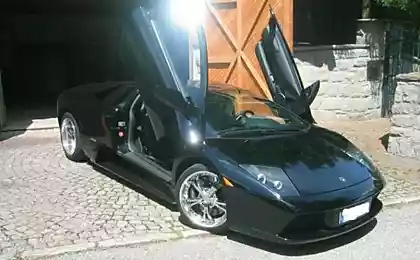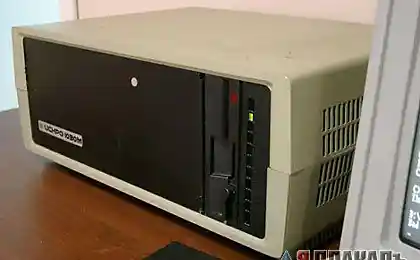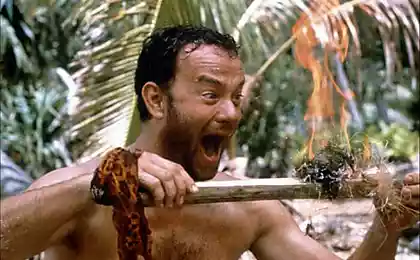700
Without the spark will kindle the flame!
About the launch of diesel and gasoline engines in the cold
It will be a pair of photons and some of the text, please do not break, I will inform finish.
What is the engine easier to start in cold weather, petrol or diesel? When we drove in a climatic chamber, two Peugeot 408, a gasoline-aspirated 1.6 and the second with a turbodiesel of the same working volume, I was also sure that I know the right answer.
Adapted for use here

What is needed for the successful launch of the internal combustion engine? The answer is clear: a stable ignition of the fuel-air mixture in the combustion chamber.
The gasoline engine with fuel injection, both in our Peugeot, fuel-air mixture being prepared before they arrive at the cylinders, and hence is a homogeneous, ie homogeneous. A spark from the spark will ignite it with the proviso that the gasoline vapor and air will be at a certain ratio, and in a fairly narrow range. In addition, the volatility of fuel must not be less than the permissible level, otherwise fuel will begin to condense on the cold walls of the intake manifold - and if there will be too much, he simply flood the candles on the intake stroke.
With a diesel engine the picture is different. In the cylinder on the intake stroke, no air-fuel mixture is supplied, but only air. The very same diesel fuel is injected directly into the combustion chamber, and at the end of the compression stroke. That is, the mixture is prepared directly in the cylinder - and because it is heterogeneous, that is diverse. Inflammation begins on the Limits of the spray of fuel, that is, where the locally formed "correct" composition of the mixture capable of ignition. And in this sense, the diesel engine has an advantage: the quality of starting a much lesser extent depend on the fuel volatility, and the quality of the fuel-air mixture.
But all of us, from personal experience or hearsay, know that in the fierce cold did not run the risk of a diesel engine is much higher than in the case of a gasoline engine. Why?
First of all, because at low temperatures, diesel motor is particularly important "trigger" engine speed. If the battery is hooked on the cold starter and could barely rotate the crankshaft in the oil thickened, then the diesel engine, ie the engine compression ignition, there is a chance to start. The air in the cylinders is compressed slowly, some of it manages to seep through the gaps between the cylinder and piston rings, so that the pressure at the end of the compression stroke is insufficient to achieve the desired temperature for ignition. In the petrol motor in such a situation, the chances of really higher.
And that showed our cold starts?
Such an experiment is not the first time we perform. Nearly four years ago (AP №1, 2010) we are in the same laboratory compared the launchers quality two vans - Gazelle gasoline and diesel Ducato. Then there was the even overcome the initial barriers - 25-degree frost none of the vans not start (according to our rules allowed three attempts to start 15 seconds each). Although Gazelle tank was filled winter fuel for the temperate climate and the Ducato was altogether filled with Arctic diesel fuel.
At this time, the fuel is the same. As usual, before the experiment, we checked it out in an accredited laboratory. Limit filterability temperature of diesel fuel minus 60 ° C - this is a real arctic diesel fuel! A vapor pressure, determining the volatility of petrol (in the case of the Peugeot 408 is the AI-95 and Gazelle was filled with 92 RON), was found to be 74 kPa, which is within the norm (65-95 kPa) for the winter gasoline volatility with a fourth class the old GOST 51105-97. Alas, the current technical regulations allow much greater pluralism: our gasoline can equally well be termed as the winter (50-100 kPa) and summer (45-80 kPa).
Petrol Peugeot 408 - the same car, which is now completing a marathon of our accelerated life tests, so prior to the experiment, we put new candles. The housings of both cars - fresh oil Total Quartz Ineo First 0W-30, recommended by Peugeot for temperatures below minus 30 ° C. But diesel cars and higher battery capacity (70 instead of 60 Ah), and more powerful starter motor (1, 4 kW against 0, 9). The first line in 25 degrees below zero, both cars took playfully: the engine starts immediately. And incidentally reiterated that diesel - motor "cold". After a two-minute warm-up idling and subsequent 20-minute operation at the speed equal to half of the engine speed corresponding to maximum power, the temperature of the oil in a diesel engine was 28 ° C lower than in a gasoline engine, a coolant temperature - all 35 ° FROM! Even though the diesel Peugeot equipped kilowatt electric heater air and automatic control of the heater (petrol sibling was a simple little "stove"), in the cabin of diesel cars it was much colder: six degrees less at the level of the driver and eight - in the back row.
The next frontier - 30 degrees below zero. Beaudry rumble from under the hood of the diesel car was heard after the three seconds of the starter! But the gasoline engine at the first attempt has been wound up, but a second later stalled. During the second attempt, the starter of the used active as long as the engine is not left to idle. However, a limit of 15 seconds was not exceeded - offset.
But another barrier minus 33 ° C, the gasoline engine is not obeyed. Starter worked cheerfully vnezachetnyh even in the fourth and fifth attempts, when I tried to play along with the motor gas pedal. Single flash in the cylinders were the result - no. The problem, apparently, in the calibration of the injection and ignition. Fiat Albea, for example, we plant in the 33-degree cold, and with the worst gasoline volatility (vapor pressure was 2, 2 kPa below).
A diesel? Four seconds on a warm glow, five seconds vigorous work ... starter and run half a minute stalled, but to put it on again at the second attempt had no difficulty.
Fantastic? Nothing extraordinary. If diesel fuel is pumped through a fine filter (s Arctic oil pumped!), If the starter and the battery provides a nominal starting momentum, then stop diesel start the engine can only poor dispersibility thickening in cold weather diesel and too low temperature in the intake manifold, in this case - in climatic chamber. And we know its meaning: at minus 36 ° C diesel engine does not start. By the way, in the course of our "cold" test once this threshold has been taken. The record, though with the caveat was the Chevy Niva, although an attempt was vnezachetnoy - we put under the hood of a warm battery. A diesel Peugeot and even showed signs of life in the form of single flashes, but the engine has not earned. It did not help either triple baking candles or exemplary work of the starter, who famously turned the crankshaft during the first two 15-second attempts, but on the third attempt began to turn sour.
Oil viscosity increased, it was sprayed worse and the temperature of the compressed air in the combustion chamber appears to have been already insufficient for stable ignition. Try to warm the air in the intake manifold, as is done by experienced truck drivers? But then it would be possible poshamanil with a petrol engine: we inject into the reservoir a little ether - and it would probably also come to life.
In the meantime, I suggest this conclusion. Being serviceable, even without a preheater, a modern diesel engine with a battery in a frost-injection plant is not worse than gasoline engine with multipoint injection. Of course, with proper fuel. And starting preheater - even more so.
Novy Urengoy, where the heaters are equipped with almost all the cars, trucks and diesel buses run on a par with petrol. Less become afraid of diesel and private traders. For example, in the Yamalo-Nenets and Khanty-Mansi Autonomous Okrug Toyota Land Cruiser 200 sold equally well in both petrol and diesel version.
But the owners of diesel cars, living in central Russia, in a sense, are even worse off. With the abolition in 2008 of state standards and replace them with the technical regulations "On requirements for automobile and aviation gasoline, diesel and marine fuel, jet fuel and heating oil" disappeared requirement to move at certain periods during the winter grade fuel. The owners of gas stations and refineries (refinery) themselves are now free to determine when to begin selling winter diesel fuel. And because its cost for the refinery and as a result, the wholesale price considerably higher than in the summer, the fat will be lower even though the October-December traditionally accounts for the jump in retail prices for diesel fuel. And if in Moscow and St. Petersburg strong competition still contributes to a more or less timely transition to diesel for the season, in many regions of the pull to the last. Hvatanut summer diesel can be in December! Waxes produced in a freezing summer diesel fuel, can clog the fuel filter even at five degrees below zero! If you sell the "transitional" diesel fuel, the bad moment can be delayed up to minus 15-20 ° C. At such temperatures, the owners of petrol vehicles are not yet thinking about possible problems with starting the engine.
And sold in shops and petrol stations depressants, even the most effective, able to lower the temperature limit of filterability at best five or six degrees. Therefore, in case of severe frosts main recommendation to owners of diesel cars is this: look before filling in the passport of the proposed fuel quality, look for the limiting temperature of filterability and act "for the weather." Quality winter diesel fuel in Russia is, at least in Moscow and the region. For example, during our audit, conducted in 2008, at the Shell gas station we bought a diesel filterability limit temperature minus 34 ° C, and BP - minus 35 ° C. On this Russian diesel fuel Peugeot 408 1.6 HDi, has electric heating of the fuel filter, just be wound up in 33-degree frost.
Buy arctic diesel in Moscow, near Pskov and Ryazan on conventional filling stations impossible. Its like a sports petrol with an octane number more than a hundred, sold in drums specialized firms. But if you want to buy a couple of barrels of "just in case," remember that because of the abundance of light fractions from the Arctic cetane number of diesel fuel is much lower, typically 44-45 instead of 47-48 at the winter varieties, and 51 and above - from the summer diesel fuel. Due to the changing nature of the combustion process, the load on the cylinder-piston group increases. So that modern diesel Calculated on the cetane number is not lower than 51, will work harder, louder and become more voracious.
And, of course, in addition to the proper fuel for a reliable start of the winter need good battery life and thinner oil. However, these rules are valid for any type of internal combustion engine - with spark ignition even though compression. In a diesel engine the fuel is ignited by contact with hot air. Therefore, the proper starting speed ensuring sufficient heating of the air in the compression stroke, for diesel remain the most important two factors. Firstly, the air temperature in the intake manifold: the lower it is, the more the lower the temperature in the cylinder at the end of the compression stroke. Secondly, the viscosity of the fuel - it is thinner than, the wider the spray pattern and the better its ignition. For the petrol engine capacity of important spark and the right balance of gasoline vapor and air
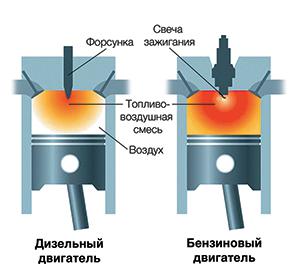
At the diesel Peugeot (left) the windshield is defrosted better, but this is because the automatic climate control system in the 25-degree frost is given priority to heating the glass, pointing at him, and the heat from the kilowatt electric heater. A gasoline sedan, equipped with a "stove" with manual settings were recorded: the distribution of air flows - on the glass and in the legs; Fan speed - third. 20 minutes windshield petrol Peugeot (pictured right) was cleared of ice only a quarter - in the history of our tests in the climatic chamber only made worse Lada Granta, otogrevshaya windscreen only two small speck

Speed defrost rear window depends mainly on the capacity of its electrical heating. At the petrol and diesel sedans it is the same - Peugeot 408 was heated rear window as effectively as, for example, Hyundai Solaris
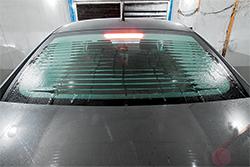
Change the batteries for Peugeot 408, and even in the fierce cold - the enemy does not want. First you need to carefully remove the cold brittle plastic casing, and on the gasoline car - and even the intake silencer. Then bring an assistant, that he assigned the bracket with the wires that prevents releasing the battery pack

Below is a description of zones warm interior

The dynamics of the warm-salons we estimate at 25-degree frost. Two thermocouples measure the temperature in the legs and head of the driver, a couple of sensors - in the legs and head back passenger. We turn on the heater after a two-minute warm-up at idle, along with the promotion of the crankshaft revolutions to 50% of maximum power (1800 rev / min for diesel and 3,000 rev / min for gasoline engine). Sensor readings are read every minute for twenty minutes.
Diesel, as expected, less generous heat. Despite the presence of kilowatt electric heater and flexible automatic control of the heater, diesel saloon car warmed much worse: in all four control points of the temperature at the end of the scoring dvadtsatiminutki was at 5-8 ° C lower than that of gasoline cars
I have everything, all successful start !!!
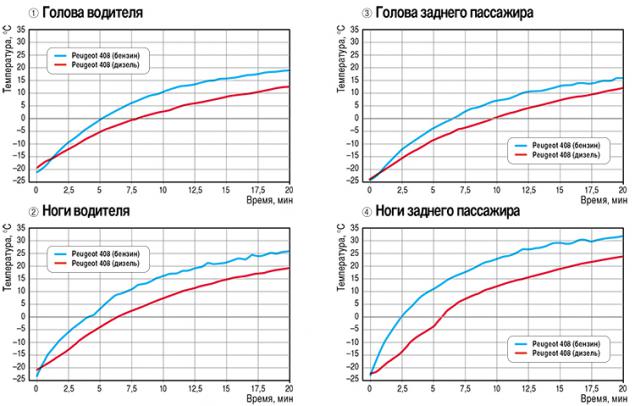
Source:
It will be a pair of photons and some of the text, please do not break, I will inform finish.
What is the engine easier to start in cold weather, petrol or diesel? When we drove in a climatic chamber, two Peugeot 408, a gasoline-aspirated 1.6 and the second with a turbodiesel of the same working volume, I was also sure that I know the right answer.
Adapted for use here

What is needed for the successful launch of the internal combustion engine? The answer is clear: a stable ignition of the fuel-air mixture in the combustion chamber.
The gasoline engine with fuel injection, both in our Peugeot, fuel-air mixture being prepared before they arrive at the cylinders, and hence is a homogeneous, ie homogeneous. A spark from the spark will ignite it with the proviso that the gasoline vapor and air will be at a certain ratio, and in a fairly narrow range. In addition, the volatility of fuel must not be less than the permissible level, otherwise fuel will begin to condense on the cold walls of the intake manifold - and if there will be too much, he simply flood the candles on the intake stroke.
With a diesel engine the picture is different. In the cylinder on the intake stroke, no air-fuel mixture is supplied, but only air. The very same diesel fuel is injected directly into the combustion chamber, and at the end of the compression stroke. That is, the mixture is prepared directly in the cylinder - and because it is heterogeneous, that is diverse. Inflammation begins on the Limits of the spray of fuel, that is, where the locally formed "correct" composition of the mixture capable of ignition. And in this sense, the diesel engine has an advantage: the quality of starting a much lesser extent depend on the fuel volatility, and the quality of the fuel-air mixture.
But all of us, from personal experience or hearsay, know that in the fierce cold did not run the risk of a diesel engine is much higher than in the case of a gasoline engine. Why?
First of all, because at low temperatures, diesel motor is particularly important "trigger" engine speed. If the battery is hooked on the cold starter and could barely rotate the crankshaft in the oil thickened, then the diesel engine, ie the engine compression ignition, there is a chance to start. The air in the cylinders is compressed slowly, some of it manages to seep through the gaps between the cylinder and piston rings, so that the pressure at the end of the compression stroke is insufficient to achieve the desired temperature for ignition. In the petrol motor in such a situation, the chances of really higher.
And that showed our cold starts?
Such an experiment is not the first time we perform. Nearly four years ago (AP №1, 2010) we are in the same laboratory compared the launchers quality two vans - Gazelle gasoline and diesel Ducato. Then there was the even overcome the initial barriers - 25-degree frost none of the vans not start (according to our rules allowed three attempts to start 15 seconds each). Although Gazelle tank was filled winter fuel for the temperate climate and the Ducato was altogether filled with Arctic diesel fuel.
At this time, the fuel is the same. As usual, before the experiment, we checked it out in an accredited laboratory. Limit filterability temperature of diesel fuel minus 60 ° C - this is a real arctic diesel fuel! A vapor pressure, determining the volatility of petrol (in the case of the Peugeot 408 is the AI-95 and Gazelle was filled with 92 RON), was found to be 74 kPa, which is within the norm (65-95 kPa) for the winter gasoline volatility with a fourth class the old GOST 51105-97. Alas, the current technical regulations allow much greater pluralism: our gasoline can equally well be termed as the winter (50-100 kPa) and summer (45-80 kPa).
Petrol Peugeot 408 - the same car, which is now completing a marathon of our accelerated life tests, so prior to the experiment, we put new candles. The housings of both cars - fresh oil Total Quartz Ineo First 0W-30, recommended by Peugeot for temperatures below minus 30 ° C. But diesel cars and higher battery capacity (70 instead of 60 Ah), and more powerful starter motor (1, 4 kW against 0, 9). The first line in 25 degrees below zero, both cars took playfully: the engine starts immediately. And incidentally reiterated that diesel - motor "cold". After a two-minute warm-up idling and subsequent 20-minute operation at the speed equal to half of the engine speed corresponding to maximum power, the temperature of the oil in a diesel engine was 28 ° C lower than in a gasoline engine, a coolant temperature - all 35 ° FROM! Even though the diesel Peugeot equipped kilowatt electric heater air and automatic control of the heater (petrol sibling was a simple little "stove"), in the cabin of diesel cars it was much colder: six degrees less at the level of the driver and eight - in the back row.
The next frontier - 30 degrees below zero. Beaudry rumble from under the hood of the diesel car was heard after the three seconds of the starter! But the gasoline engine at the first attempt has been wound up, but a second later stalled. During the second attempt, the starter of the used active as long as the engine is not left to idle. However, a limit of 15 seconds was not exceeded - offset.
But another barrier minus 33 ° C, the gasoline engine is not obeyed. Starter worked cheerfully vnezachetnyh even in the fourth and fifth attempts, when I tried to play along with the motor gas pedal. Single flash in the cylinders were the result - no. The problem, apparently, in the calibration of the injection and ignition. Fiat Albea, for example, we plant in the 33-degree cold, and with the worst gasoline volatility (vapor pressure was 2, 2 kPa below).
A diesel? Four seconds on a warm glow, five seconds vigorous work ... starter and run half a minute stalled, but to put it on again at the second attempt had no difficulty.
Fantastic? Nothing extraordinary. If diesel fuel is pumped through a fine filter (s Arctic oil pumped!), If the starter and the battery provides a nominal starting momentum, then stop diesel start the engine can only poor dispersibility thickening in cold weather diesel and too low temperature in the intake manifold, in this case - in climatic chamber. And we know its meaning: at minus 36 ° C diesel engine does not start. By the way, in the course of our "cold" test once this threshold has been taken. The record, though with the caveat was the Chevy Niva, although an attempt was vnezachetnoy - we put under the hood of a warm battery. A diesel Peugeot and even showed signs of life in the form of single flashes, but the engine has not earned. It did not help either triple baking candles or exemplary work of the starter, who famously turned the crankshaft during the first two 15-second attempts, but on the third attempt began to turn sour.
Oil viscosity increased, it was sprayed worse and the temperature of the compressed air in the combustion chamber appears to have been already insufficient for stable ignition. Try to warm the air in the intake manifold, as is done by experienced truck drivers? But then it would be possible poshamanil with a petrol engine: we inject into the reservoir a little ether - and it would probably also come to life.
In the meantime, I suggest this conclusion. Being serviceable, even without a preheater, a modern diesel engine with a battery in a frost-injection plant is not worse than gasoline engine with multipoint injection. Of course, with proper fuel. And starting preheater - even more so.
Novy Urengoy, where the heaters are equipped with almost all the cars, trucks and diesel buses run on a par with petrol. Less become afraid of diesel and private traders. For example, in the Yamalo-Nenets and Khanty-Mansi Autonomous Okrug Toyota Land Cruiser 200 sold equally well in both petrol and diesel version.
But the owners of diesel cars, living in central Russia, in a sense, are even worse off. With the abolition in 2008 of state standards and replace them with the technical regulations "On requirements for automobile and aviation gasoline, diesel and marine fuel, jet fuel and heating oil" disappeared requirement to move at certain periods during the winter grade fuel. The owners of gas stations and refineries (refinery) themselves are now free to determine when to begin selling winter diesel fuel. And because its cost for the refinery and as a result, the wholesale price considerably higher than in the summer, the fat will be lower even though the October-December traditionally accounts for the jump in retail prices for diesel fuel. And if in Moscow and St. Petersburg strong competition still contributes to a more or less timely transition to diesel for the season, in many regions of the pull to the last. Hvatanut summer diesel can be in December! Waxes produced in a freezing summer diesel fuel, can clog the fuel filter even at five degrees below zero! If you sell the "transitional" diesel fuel, the bad moment can be delayed up to minus 15-20 ° C. At such temperatures, the owners of petrol vehicles are not yet thinking about possible problems with starting the engine.
And sold in shops and petrol stations depressants, even the most effective, able to lower the temperature limit of filterability at best five or six degrees. Therefore, in case of severe frosts main recommendation to owners of diesel cars is this: look before filling in the passport of the proposed fuel quality, look for the limiting temperature of filterability and act "for the weather." Quality winter diesel fuel in Russia is, at least in Moscow and the region. For example, during our audit, conducted in 2008, at the Shell gas station we bought a diesel filterability limit temperature minus 34 ° C, and BP - minus 35 ° C. On this Russian diesel fuel Peugeot 408 1.6 HDi, has electric heating of the fuel filter, just be wound up in 33-degree frost.
Buy arctic diesel in Moscow, near Pskov and Ryazan on conventional filling stations impossible. Its like a sports petrol with an octane number more than a hundred, sold in drums specialized firms. But if you want to buy a couple of barrels of "just in case," remember that because of the abundance of light fractions from the Arctic cetane number of diesel fuel is much lower, typically 44-45 instead of 47-48 at the winter varieties, and 51 and above - from the summer diesel fuel. Due to the changing nature of the combustion process, the load on the cylinder-piston group increases. So that modern diesel Calculated on the cetane number is not lower than 51, will work harder, louder and become more voracious.
And, of course, in addition to the proper fuel for a reliable start of the winter need good battery life and thinner oil. However, these rules are valid for any type of internal combustion engine - with spark ignition even though compression. In a diesel engine the fuel is ignited by contact with hot air. Therefore, the proper starting speed ensuring sufficient heating of the air in the compression stroke, for diesel remain the most important two factors. Firstly, the air temperature in the intake manifold: the lower it is, the more the lower the temperature in the cylinder at the end of the compression stroke. Secondly, the viscosity of the fuel - it is thinner than, the wider the spray pattern and the better its ignition. For the petrol engine capacity of important spark and the right balance of gasoline vapor and air

At the diesel Peugeot (left) the windshield is defrosted better, but this is because the automatic climate control system in the 25-degree frost is given priority to heating the glass, pointing at him, and the heat from the kilowatt electric heater. A gasoline sedan, equipped with a "stove" with manual settings were recorded: the distribution of air flows - on the glass and in the legs; Fan speed - third. 20 minutes windshield petrol Peugeot (pictured right) was cleared of ice only a quarter - in the history of our tests in the climatic chamber only made worse Lada Granta, otogrevshaya windscreen only two small speck

Speed defrost rear window depends mainly on the capacity of its electrical heating. At the petrol and diesel sedans it is the same - Peugeot 408 was heated rear window as effectively as, for example, Hyundai Solaris

Change the batteries for Peugeot 408, and even in the fierce cold - the enemy does not want. First you need to carefully remove the cold brittle plastic casing, and on the gasoline car - and even the intake silencer. Then bring an assistant, that he assigned the bracket with the wires that prevents releasing the battery pack

Below is a description of zones warm interior

The dynamics of the warm-salons we estimate at 25-degree frost. Two thermocouples measure the temperature in the legs and head of the driver, a couple of sensors - in the legs and head back passenger. We turn on the heater after a two-minute warm-up at idle, along with the promotion of the crankshaft revolutions to 50% of maximum power (1800 rev / min for diesel and 3,000 rev / min for gasoline engine). Sensor readings are read every minute for twenty minutes.
Diesel, as expected, less generous heat. Despite the presence of kilowatt electric heater and flexible automatic control of the heater, diesel saloon car warmed much worse: in all four control points of the temperature at the end of the scoring dvadtsatiminutki was at 5-8 ° C lower than that of gasoline cars
I have everything, all successful start !!!

Source:



